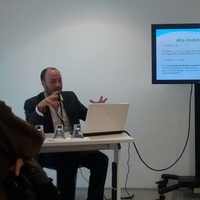Papers by Jeanbenoit Zimmermann
Économie publique/Public economics, 2012
Économie publique/Public economics, 2004
études et recherches Revue de l'Institut d'Économie Publique Deux numéros par an n o 13-2003/2 éc... more études et recherches Revue de l'Institut d'Économie Publique Deux numéros par an n o 13-2003/2 économiepublique sur internet : www.idep-fr.org > Publications c Institut d'économie publique-IDEP Centre de la Vieille-Charité 2, rue de la Charité-F-13002 Marseille Tous droits réservés pour tous pays.
G R E Q a M, 1996
The aim of this paper is to lay the foundations of a social influence based approach for the diff... more The aim of this paper is to lay the foundations of a social influence based approach for the diffusion of an innovation or a technological standard.
G R E Q a M, 1997
The purpose of this paper is to propose an approach of the firms-territories relationships that s... more The purpose of this paper is to propose an approach of the firms-territories relationships that should not be restricted to the sole point of view of the localisation's theory. Such an approach aims then to refer to a continous temporality that should not reduced to the sole moments of an attraction-localisation game that is the one of the "territories' competition" paradigm.
Les strategies d'attractivite mises en oeuvre par les territoires pour attirer des investisse... more Les strategies d'attractivite mises en oeuvre par les territoires pour attirer des investissements productifs en quete de localisation induisent une distinction entre deux types d'investissements selon leur origine, endogene ou non. Toute firme etant nee dans un contexte territorial donne, parler de firme "alllogene suppose qu'a un moment dans son histoire, l'entreprise ait ete conduite a prendre des distances avec ce territoire d'origine, pour initier un deploiement spatial elargi. Ce phenomene constitue un des aspects majeurs de la globalisation. L'exemple de Gemplus Card, presente ici, est celui d'une entreprise nee dans un contexte territorial fort.

European Journal of Economic and Social Systems, 2001
The aim of this paper is the presentation of an approach of firms-territories relationships in te... more The aim of this paper is the presentation of an approach of firms-territories relationships in terms of firms' nomadism and territorial anchorage of technological and industrial activities. Such an approach is founded on the necessity to overcome the "volatile" firm's level of analysis, in which firm's mobility is investigated from the sole point of view of the leaven location. On the contrary, it should be relevant to focus on the firm's dynamics through its connections with the whole set of territories and to conceive the firm-territory relation as a result of the dialectic confrontation of the respectively concerned firm and territory both dynamics, both trajectories. Hence we are led to characterise the localised industrial unit as placed at the crossroad of a triple link: with a firm (or a group), with an industry and with a territory. Such a threefold coupling relies on proximity's effects, alternately from organisational and geographical nature, whose conjunction generates territorial anchoring and leads to the notion of productive encounter, in the sense of a capacity to formulate and give solutions to productive issues, within the context of firm-territory relationship. In terms of formal models, research works are at the very first step. Nevertheless, an approach in terms of "small worlds" seems to present very fruitful perspectives. We develop the foundations of such an approach and expose how it can provide a good framework to explain territorial anchorage and, more widely, the strength of clusters. A concrete illustration is extensively developed about SGS-Thomson Microelectronics group with regard to its productive site in Rousset, in the French Bouches-du-Rhône district.

Revue d'économie industrielle, 1984
L'électronique constitue un marché mondial dominé par des firmes multinationales. Leurs strat... more L'électronique constitue un marché mondial dominé par des firmes multinationales. Leurs stratégies sont étroitement marquées par les spécificités de leurs espaces nationaux d'origine. Les groupes US ont assuré leur expansion internationale par la multinationalisation. Les firmes japonaises ont privilégié les exportations. Les européens, plus retranchés à l'abri de leurs frontières nationales, ont favorisé les alliances avec les groupes dominants US et japonais au détriment du renforcement des liens intracommunautaires. La politique industrielle européenne devrait s'efforcer de bâtir une cohérence communautaire tant au plan de la stratégie des firmes que de la recherche de produits différenciés mieux adaptés aux spécificités des marchés européens. L'électronique constitue un marché mondial dominé par des firmes multinationales. Leurs stratégies sont étroitement marquées par les spécificités de leurs espaces nationaux d'origine. Les groupes US ont assuré leur e...
Lecture Notes in Economics and Mathematical Systems, 2001
The use of general descriptive names, registered names, trademarks, etc. in this publication does... more The use of general descriptive names, registered names, trademarks, etc. in this publication does not imply, even in the absence of a specific statement, that such names are exempt from the relevant protective laws and regulations and therefore free for general use.

SSRN Electronic Journal, 2015
This paper sheds new light on the economic logic of voluntary associations and the relationship b... more This paper sheds new light on the economic logic of voluntary associations and the relationship between individual contribution and collective action. The aims are twofold. Firstly, we seek to explain how "team reasoning" (Bacharach et al. 2006) can deeply change the functioning of voluntary associations (which are considered to produce a public good) when some or all of the individual members group together to make collective decisions about their involvement or contribution, rather than deciding separately. Secondly, we seek to better understand the effects of heterogeneity of resources on individual involvement, in terms of both the budget constraints of individual members and their capacity to contribute differentiated non-monetary contributions to the association, in relation to the diversity of their personal abilities and preferences about the characteristics of the good produced. To this end, we use a model of voluntary association collectively producing a public good, where monetary contributions (compulsory fees plus voluntary donations) is combined with volunteering. We analyze the conditions for an association to offer profitable conditions to its members and the consequences that can be drawn in terms of its existence and size. We show that, at equilibrium, the level of voluntary contributions is ceteris paribus higher when individuals make their decisions on the basis of team-reasoning rather than individually. We analyze the role played by heterogeneity of incomes in the formation of teams within associations. We then introduce the concept of subjective quality into the basic model. The originality of the model is that we assume the public good to be characterized by at least two main components: quantity and quality. The quantity is considered here as a purely public component, insofar as all the members benefit equally from it. However, the quality of the public good is assumed to be a mixed (public and private) component. The agents can enjoy part of it in the same way, but there may be certain characteristics of quality that are difficult or impossible to measure objectively. Quality is always somewhat subjective, to the extent that perfect correspondence with the preferences of heterogeneous agents is unlikely to occur. In our model, the agents can contribute money and/or time and effort. The latter, which we call volunteering, allows them to influence the quality of the good (or service) provided according to their own preferences.
Lecture Notes in Economics and Mathematical Systems, 2004

Revue d'économie industrielle, 2002
Though software intellectual property could not satisfactorily fall into any existing legal frame... more Though software intellectual property could not satisfactorily fall into any existing legal framework, all countries have taken the decision to range it under the category of copyright. Then the double objective of intellectual property protection is not satisfied, which consists, on the one hand, to grant to the inventor a provisional monopoly for exploiting his invention and, on the other hand, to oblige him to disclose the principles of his invention. To resort to the patents system as it became more and more usual in the US and which is in debate in Europe, raise other kind of problems. Now the alternative model of Open Source Software, based on a very peculiar juridical tool called GPL « General Public Licence », tends to take a growing importance. Its main principle is to impose to its adopters to disclose the source-code of the concerned programs and of any further improvement, as well as the free circulation of the code under the sole condition to maintain its « open » chara...
Rives méditerranéennes, 2000
Du bassin houiller de Gardanne au pôle micro-électronique provençal : reconv... Rives méditerrané... more Du bassin houiller de Gardanne au pôle micro-électronique provençal : reconv... Rives méditerranéennes, 4 | 2003 Du bassin houiller de Gardanne au pôle micro-électronique provençal : reconv...
Revue d'économie industrielle, 1987
L'article s'attache en premier lieu à préciser la spécificité de l'industrie du trait... more L'article s'attache en premier lieu à préciser la spécificité de l'industrie du traitement de l'information à l'égard du concept de grappe technologique. Le cas d'Olivetti, examiné ensuite, depuis son redressement spectaculaire à partir de 1978, présente-t-il pour l'industrie européenne un caractère d'exemplarité ? Restructuré autour d'un effort interne et externe d'élargissement de son potentiel technologique, elle a, en fait, axé en priorité sa stratégie d'alliance vers l'accession à une taille de leader. Son récent accord avec ATT lui a permis de réaliser un progrès important sur le marché US. Mais, l'ombre du géant américain ne portera-t-elle pas atteinte à sa croissance ?

Internet and Digital Economics
This paper deals with open software as an innovation system based on knowledge accessibility. It ... more This paper deals with open software as an innovation system based on knowledge accessibility. It addresses four issues: welfare implications, incentives, the legal framework and the coalitions involved. For economists, knowledge accessibility is viewed as a mechanism which generates e¢ cient outcomes. The welfare implications are clear: no monopoly distorsion; spillovers do not reduce but rather increase innovator's incentives. These welfare implications are magni…ed in the case of open source because software bene…ts from unlimited increasing returns in terms of production as well as in terms of di¤usion. The basic problem when discussing incentives is to understand why voluntary spillovers occur at all. Economists will try to answer by exploring those mechanisms which allow agents to obtain a private bene…t by freely revealing their innovative work. Actually, for any system promoting knowledge openness, incentives are necessary to

SSRN Electronic Journal, 2005
In this paper we model the formation of innovation networks as they emerge from bilateral actions... more In this paper we model the formation of innovation networks as they emerge from bilateral actions. In contrast to much of the literature, here firms only consider knowledge production, and not network issues when deciding on partners. Thus we focus attention on the effects of the knowledge and information regime on network formation. The effectiveness of a bilateral collaboration is determined by cognitive, relational and structural embeddedness. Innovation results from the recombination of knowledge held by the partners to the collaboration, and its success is determined in part by the extent to which firms' knowledge complement each other. Previous collaborations (relational embeddedness) increase the probability of a successful collaboration; as does information gained from common third parties (structural embeddedness). Repeated alliance formation creates a network. Two features are central to the innovation process: how firms pool their knowledge resources; and how firms derive information about potential partners. When innovation is decomposable into separate sub-tasks, networks tend to be dense; when structural embeddedness is important, networks become cliquish. For some regions in this parameter space, small worlds emerge.










Uploads
Papers by Jeanbenoit Zimmermann